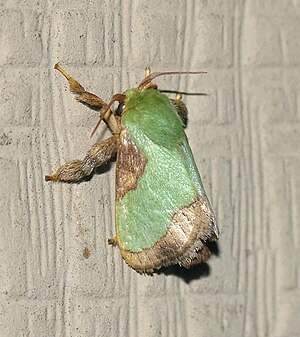Parasa indetermina
| Parasa indetermina | ||||||||||||
|---|---|---|---|---|---|---|---|---|---|---|---|---|

Parasa indetermina , male |
||||||||||||
| Systematics | ||||||||||||
|
||||||||||||
| Scientific name | ||||||||||||
| Parasa indetermina | ||||||||||||
| ( Boisduval , 1832) |
Parasa indetermina is a butterfly found in North America( moth ) from the family of the snail moth (Limacodidae).
features
butterfly
The wingspan of the moth is 23 to 30 millimeters. The top of the forewing shows light brown tones near the basal region and in the submarginal region . The middle area is large, slightly iridescent, grass-green in color and bordered on the outside by a curved line. The upper side of the hind wing is not marked and has a yellow-brown color. Males have combed antennae . The thorax is furry green and the legs are hairy brown, a proboscis is missing.
Caterpillar
Adult caterpillars have stunted legs, move like a snail and are conspicuously colored. Their basic color is yellowish to reddish. A light stripe runs down the middle of the back, from which a few thin, purple-colored lines stand out. There are also some dark lines on the sides. On the body surface there are several horn-like outgrowths, from which short thorns extend. The conspicuous coloring is to be understood as a warning color for potential enemies.
Similar species
The moths of Parasa chloris are smaller and also differ by the almost straight outer boundary line of the green area on the upper side of the forewing .
Distribution and occurrence
Parasa indetermina occurs locally in the east to the middle of the USA . The species prefers to colonize lush deciduous forests and parks.
Way of life
The nocturnal moths appear between June and July. You visit artificial light sources . The females lay eggs at the end of July, from which the young caterpillars hatch after about nine days. These like to hide on the underside of leaves. They are polyphagous and feed on the leaves of various trees and shrubs, including oak ( Quercus ), dogwood ( Cornus ), maple ( Acer ), poplar ( Populus ) and hickory ( Carya ) and rose plants (Rosaceae) ). The caterpillars pupate in September and overwinter in a cocoon .
Individual evidence
- ↑ a b c Butterflies and Moths of North America: Stinging Rose Caterpillar Moth , (accessed at https://www.butterfliesandmoths.org/species/Parasa-indetermina on August 27, 2017)
- ↑ a b Jeffrey K. Barnes: Stinging Rose Caterpillar , University of Arkansas, Department of Entomology, Arthropod Museum Notes, No. 29, 2004, (viewed at Archived Copy ( Memento of the original dated June 14, 2017 in the Internet Archive ) Info: The archive link was inserted automatically and has not yet been checked. Please check the original and archive link according to the instructions and then remove this notice. On August 27, 2017)
Web links
- bugguide.net - photos
